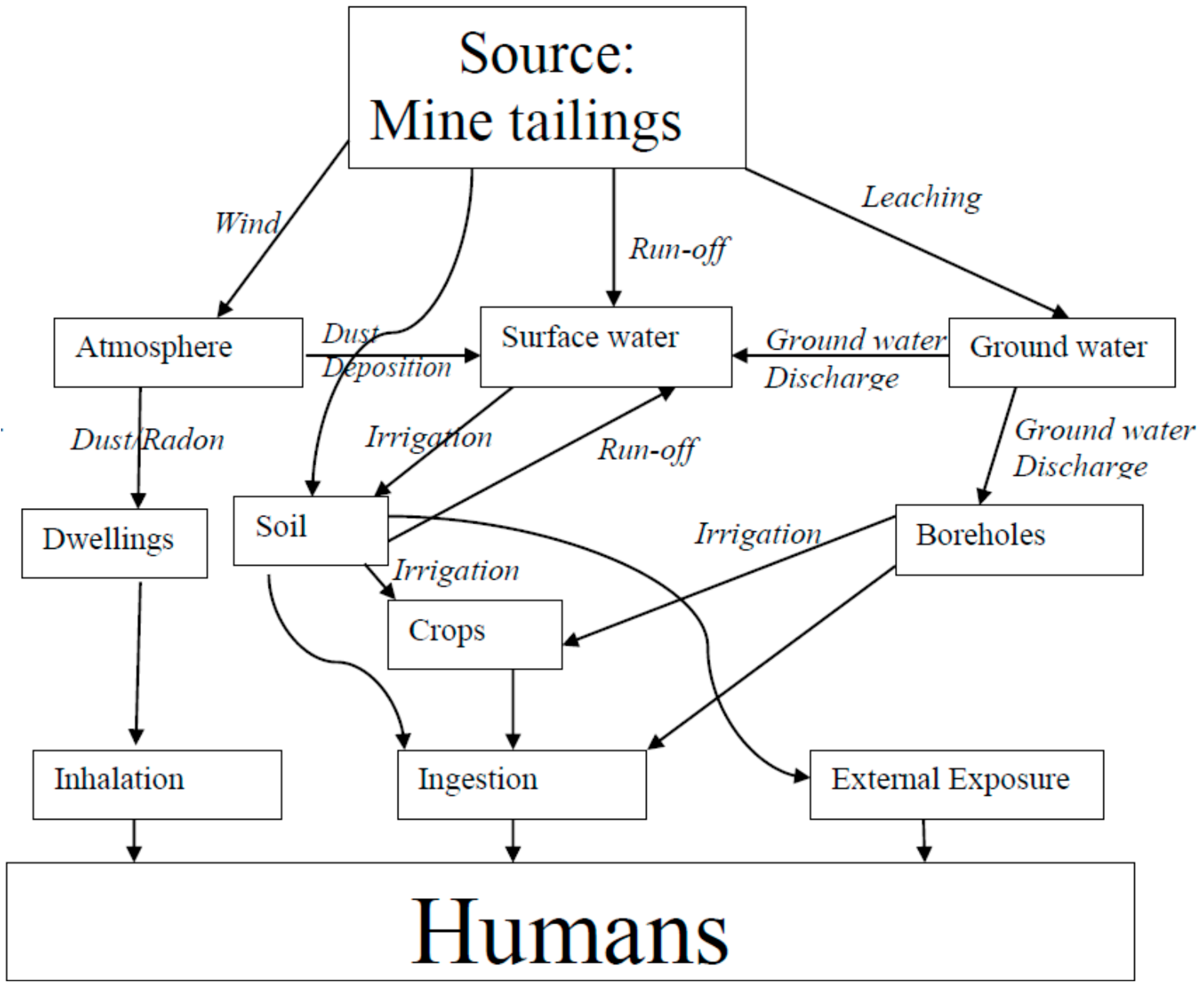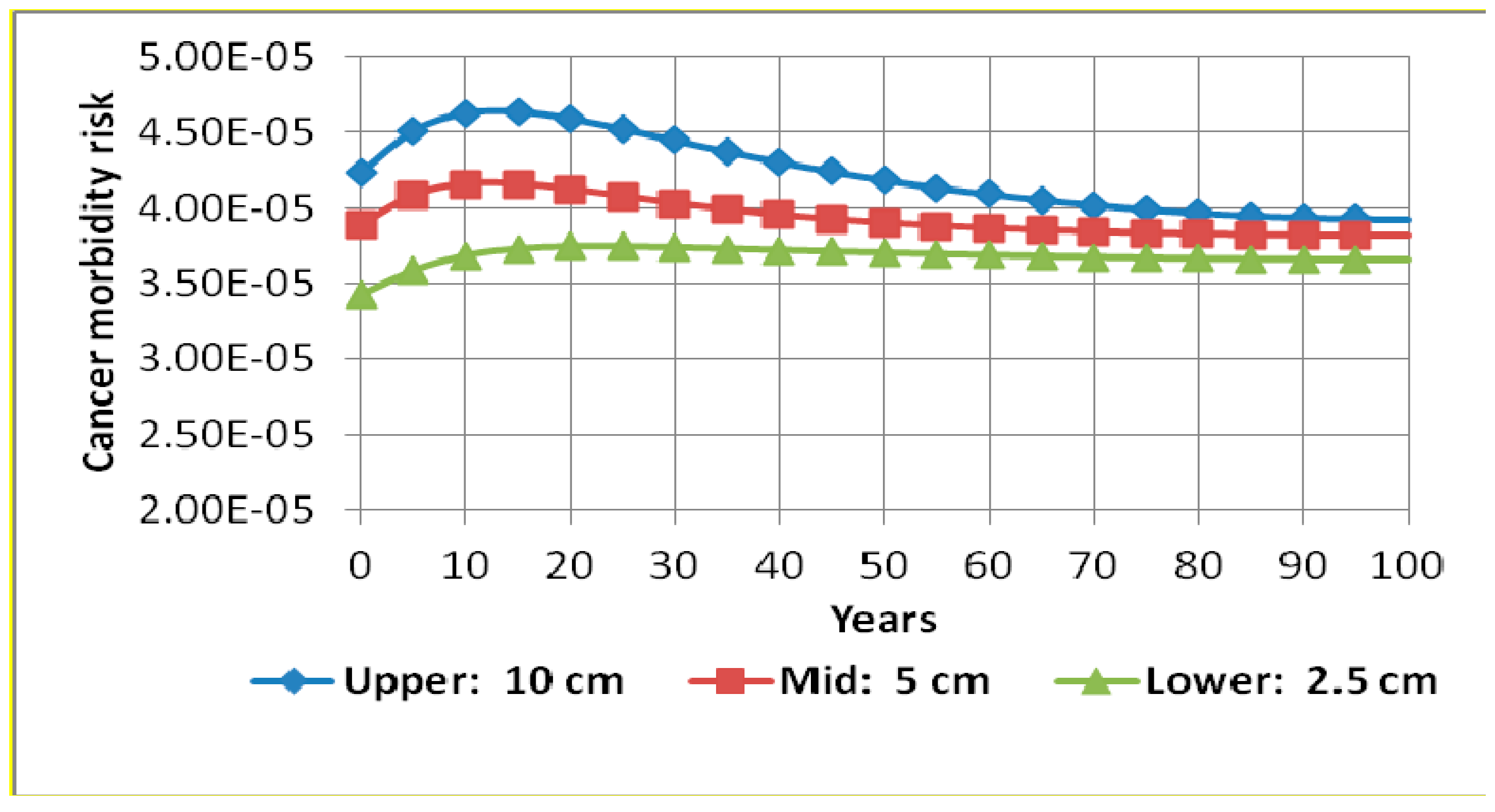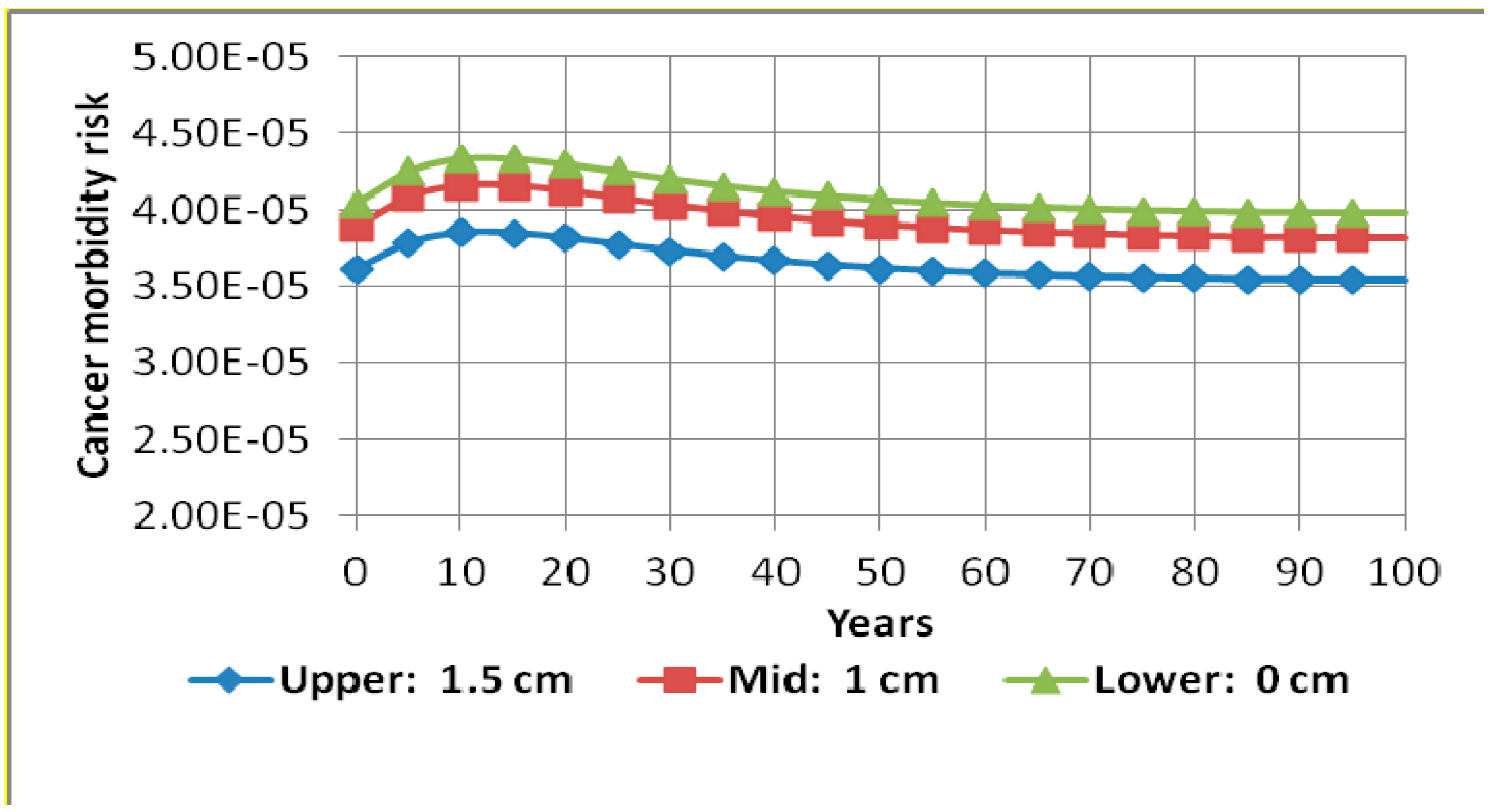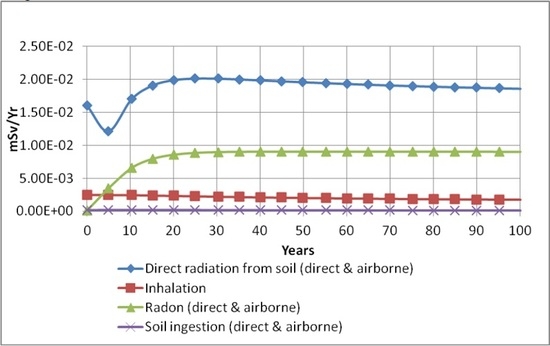Modelling of Radiological Health Risks from Gold Mine Tailings in Wonderfonteinspruit Catchment Area, South Africa
Abstract
:1. Introduction
2. Materials and Methods
2.1. The Study Area
2.2. Sampling and Measurement of Activity Concentrations
2.3. RESRAD-OFFSITE Computer Code
2.4. Transport Pathways Associated with NORMs in the Study Area
2.5. Input Parameters and Scenario Description for RESRAD-OFFSITE Code
3. Results and Discussion
3.1. NORM Activities Concentration in Soil
3.2. Radiation Doses Using RESRAD-OFFSITE Computer Code
3.3. Excess Cancer Morbidity Risk Using RESRAD-OFFSITE Computer Code
3.4. Sensitivity Analysis
4. Conclusions
Acknowledgments
Author Contributions
Conflicts of Interest
References
- Zakariya, N.I.; Kahn, M.T.E. Benefits and biological effects of ionizing radiation. Sch. Acad. J. Biosci. 2014, 2, 583–591. [Google Scholar]
- WNA (World Nuclear Association). Radiation and Nuclear Energy. Available online: http://www.world-nuclear.org/info/inf30.html (accessed on 14 November 2014).
- Nour, K.A.; Gabar, A.; Arabi, M. Natural radioactivity in farm soil and phosphate fertilizer and its environmental implications in qenagovernorate, Upper Egypt. J. Environ. Radioact. 2005, 84, 51–64. [Google Scholar]
- USEPA (United States Environmental Protection Agency). Title 40 Code of Federal Regulations, Section 70.2. 2009. Available online: http://www.gpo.gov/fdsys/pkg/CFR-2009-title40-vol15/xml/CFR-2009-title40-vol15-part70.xml (accessed on 20 October 2014). [Google Scholar]
- Ziajahromi, S.; Khanizadeh, M.; Nejadkoorki, F. Using the RESRAD code to assess human exposure risk to 226Ra, 232Th, and 40K in soil. Hum. Ecol. Risk Assess. An Int. J. 2014, 21. [Google Scholar] [CrossRef]
- Winde, F.; Wade, P.; Van der Walt, I.J. Gold tailings as a source of waterborne uranium contamination of streams–the Koekemoerspruit (Klerksdorp goldfield, South Africa) as a case study—Part I: Uranium migration along the aqueous pathway. Water SA 2004, 30, 219–226. [Google Scholar] [CrossRef]
- GDARD (Gauteng Department of Agriculture and Rural Development). Conceptual Study on Reclamation of Mine Residue Areas for Development Purposes; Final Report; Gauteng Provincial Government: Pretoria, South Africa, 2009. [Google Scholar]
- NNR (National Nuclear Regulator). Radiological impacts of the mining activities to the public in the wonderfonteinspruit Catchment Area, South Africa. In The New Uranium Mining Boom; Report–TR-RRD-07-0006; NNR: Pretoria, South Africa, 2007. [Google Scholar]
- Yu, C.; Zielen, A.J.; Cheng, J.J.; LePoire, D.J.; Gnanapragasam, E.; Kamboj, S.; Arnish, J.; Wallo III, A.; Williams, W.A.; Peterson, H. User’s Manual for RESRAD, Version 6; ANL/EAD-4; Argonne National Laboratory: Lemont, IL, USA, 2001. [Google Scholar]
- Kamunda, C.; Mathuthu, M.; Madhuku, M. Assessment of radiological hazards from gold mine tailings in Gauteng province, South Africa. Int. J. Environ. Res. Public Health 2016, 13, 138. [Google Scholar] [CrossRef] [PubMed]
- McCarthy, T.; Rubridge, B. The Story of Earth and Life; Struik Publishers: Cape Town, South Africa, 2005; pp. 89–90, 102–107, 134–136. [Google Scholar]
- DWAF (Department of Water Affairs and Forestry). Development of a Water Quality Management Plan for the Klip River Catchment. Phase 1: Situational Analysis, Draft Final Report; DWAF: Pretoria, South Africa, 1999. [Google Scholar]
- IAEA (International Atomic Energy Agency). Measurement of Radionuclides in Food and the Environment; Technical Report Series No. 295; IAEA: Vienna, Austria, 1989. [Google Scholar]
- Canberra Industries; Broad Energy Germanium Detectors (BEGe). Nuclear Measurement Solutions for Safety, Security and the Environment. Available online: http://www.canberra.com (accessed on 13 October 2015).
- David, J.; LePoire, J.J.; Arnish, T.R.; Klett, R.L.; Chen, S.Y. Pathways to Enhance Environmental Assessment Information Systems. Inf. Sci. J. 2004, 7, 117–128. [Google Scholar]
- Eckerman, K.F.; Ryman, J.C. External Exposure to Radionuclides in Air, Water, and Soil: Exposure to Dose Coefficients for General Application; Based on the 1987 Federal Radiation Protection Guidance, EPA 402-R-93–081, Federal Guidance Report No. 12; Environmental Protection Agency, Office of Radiation and Indoor Air: Washington, DC, USA, 1993. [Google Scholar]
- Smith, B. A community guide to estimating radiation doses from residual radioactive contamination. In Science for Democratic Action; Institute for Energy and Environmental Research: Takoma Park, MD, USA, 2008; Volume 15. [Google Scholar]
- USDOE (United States Department of Energy). RESRAD-OFFSITE: A Tool for Evaluating Radiation Doses and Risks to Humans; Office of Nuclear Safety and Environment: Washington, DC, USA, 2007. [Google Scholar]
- USDOE (United States Department of Energy). RESRAD-OFFSITE for Windows (Version 3.1): Nuclear Regulatory Commission, Environmental Science Division; Argonne National Laboratory: Argonne, IL, USA, 2013. [Google Scholar]
- Yu, C.; Loureiro, C.; Cheng, J.J. Data Collection Handbook to Support Modeling of the Impacts of Radioactive Material in Soil; ANL/EAIS-8; Argonne National Laboratory: Argonne, IL, USA, 1993. [Google Scholar]
- NNR (National Nuclear Regulator). RG-002 Safety Assessment to Radiation Hazards to Members of the Public from NORM Activities; NNR: Pretoria, South Africa, 2013. [Google Scholar]
- Hagemann, K. South Africa’s Wind Potential; G& Renewable Energies (Pty) Ltd.: Cape Town, South Africa, 2013. [Google Scholar]
- USEPA (United States Environmental Protection Agency). Risk assessment guidance for superfund. In Human Health Evaluation Manual, (Part A) [R], Volume 1; EPA/540/1-89/002; Office of Emergency and Remedial Response: Washington, DC, USA, 1989. [Google Scholar]





| Parameter | Value | Description and/or Reference | |
|---|---|---|---|
| Average activity concentrations of 238U, 232Th, and 40K | Table 2 | The values were based on measurements. | |
| Area of contaminated zone (m2) | 16,000,000 | This was the average estimated over the whole area. | |
| Thickness of contaminated zone (m) | 0.05 | This was the average estimated over the whole area. | |
| Cover depth (m) | 0 | There was no cover depth for the radionuclides | |
| Density of contaminated zone (g/m3) | 1.44 | For sandy loam soil [20]. | |
| Erosion rate for contaminated zone (m/year) | 0.001 | RESRAD default value [20]. | |
| Total porosity for contaminated zone | 0.43 | For sedimentary material which is sand fine [20]. | |
| Field capacity for contaminated zone | 0.2 | RESRAD default value [20]. | |
| Hydraulic conductivity of contaminated zone (m/year) | 1090 | For sandy loam soil [20]. | |
| Soil-specific exponential b parameter | 4.9 | For sandy loam soil [20]. | |
| Average annual wind speed (m/s) | 5 | For the area [22]. | |
| Evapotranspiration coefficient | 0.5 | RESRAD default value [21]. | |
| Precipitation rate (m/year) | 1 | The area is relatively humid [21]. | |
| Irrigation rate | 0.2 | RESRAD default value [21]. | |
| Runoff coefficient | 0.65 | For moderately steep, residential area. | |
| Inhalation rate (m3/year) | 8059.2 | For South Africa [21]. | |
| Exposure duration (year) | 30 | RESRAD default value [20]. | |
| Fraction of time spent onsite | Indoor | 0 | For South Africa [21]. |
| Outdoor | 0.1 | ||
| Fraction of time spent offsite | Indoor | 0.8 | For South Africa [21]. |
| Outdoor | 0.1 | ||
| Soil ingestion rate (g/year) | 37 | For South Africa [21]. | |
| Leach rate | 0 | RESRAD default value [20]. | |
| Water drinking rate (L/year) | 600 | For South Africa [21]. | |
| Distribution coefficient (Kd)-uranium (cm3/g) | 200 | For South Africa [21]. | |
| Distribution coefficient (Kd)-thorium (cm3/g) | 60,000 | RESRAD default value [20]. | |
| Distribution coefficient (Kd)-potassium (cm3/g) | 5.5 | RESRAD default value [20]. | |
| Location | No. of Samples | Parameter | Activity Concentrations (Bq∙kg−1) | ||
|---|---|---|---|---|---|
| 238U | 232Th | 40K | |||
| Control area | 10 | Average | 17.0 ± 0.4 | 22.2 ± 0.5 | 496.8 ± 15.2 |
| Min | 12.5 ± 0.3 | 16.6 ± 0.4 | 424.3 ± 13.0 | ||
| Max | 23.6 ± 0.5 | 30.4 ± 0.6 | 648.4±19.8 | ||
| Tailings one | 11 | Average | 733.4 ± 12.7 | 41.3 ± 0.9 | 339.9 ± 10.7 |
| Min | 304.4 ± 5.4 | 36.5 ± 0.8 | 271.5 ± 9.0 | ||
| Max | 1243.4 ± 21.6 | 54.5 ± 1.2 | 468.4 ± 14.6 | ||
| Tailings two | 13 | Average | 794.9 ± 13.8 | 44.9 ± 1.0 | 460.7 ±14.4 |
| Min | 616.6 ± 10.7 | 38.4 ± 0.9 | 226.5 ±7.8 | ||
| Max | 1391.8 ± 24.1 | 49.5 ± 1.1 | 681.9 ± 21.0 | ||
| Tailings three | 8 | Average | 1556.2 ± 27.0 | 59.0 ± 1.3 | 354.3 ± 11.4 |
| Min | 390.9 ± 6.8 | 22.3 ± 0.6 | 233.8 ± 7.5 | ||
| Max | 2668.9 ± 46.2 | 89.7 ± 1.9 | 497.1 ± 15.6 | ||
| Tailings four | 12 | Average | 232.0 ± 4.1 | 33.2 ± 0.8 | 489.5 ± 14.1 |
| Min | 87.2 ± 1.6 | 20.5 ± 0.6 | 257.9 ± 8.3 | ||
| Max | 618.2 ± 10.8 | 49.1 ± 1.1 | 781.0 ± 23.9 | ||
| Tailings five | 12 | Average | 609.7 ± 10.6 | 41.1 ± 0.9 | 490.7 ± 15.2 |
| Min | 236.1 ± 4.2 | 25.3 ± 0.6 | 281.2 ± 8.8 | ||
| Max | 2054.7 ± 35.6 | 67.1 ± 1.4 | 574.9 ± 17.7 | ||
| Average all tailings | 485.3 ± 13.7 | 43.9 ± 1.0 | 427.0 ± 13.1 | ||
| Year | Total Effective Dose Equivalent (mSv/Year) | |||
|---|---|---|---|---|
| Nuclides | Total | |||
| 40K | 232Th | 238U | ||
| 0 | 1.20 × 10−2 | 2.29 × 10−3 | 4.53 × 10−3 | 1.88 × 10−2 |
| 5 | 4.43 × 10−4 | 1.37 × 10−2 | 4.12 × 10−3 | 1.83 × 10−2 |
| 10 | 1.18 × 10−5 | 2.25 × 10−2 | 3.72 × 10−3 | 2.62 × 10−2 |
| 15 | 4.35 × 10−7 | 2.63 × 10−2 | 3.39 × 10−3 | 2.96 × 10−2 |
| 20 | 1.61 × 10−8 | 2.79 × 10−2 | 3.08 × 10−3 | 3.10 × 10−2 |
| 25 | 5.94 × 10−10 | 2.86 × 10−2 | 2.81 × 10−3 | 3.14 × 10−2 |
| 30 | 1.58 × 10−11 | 2.89 × 10−2 | 2.53 × 10−3 | 3.15 × 10−2 |
| 35 | 5.84 × 10−13 | 2.90 × 10−2 | 2.31 × 10−3 | 3.14 × 10−2 |
| 40 | 2.16 × 10−14 | 2.91 × 10−2 | 2.10 × 10−3 | 3.12 × 10−2 |
| 45 | 7.98 × 10−16 | 2.91 × 10−2 | 1.91 × 10−3 | 3.10 × 10−2 |
| 50 | 2.95 × 10−17 | 2.91 × 10−2 | 1.74 × 10−3 | 3.08 × 10−2 |
| 55 | 7.83 × 10−19 | 2.90 × 10−2 | 1.57 × 10−3 | 3.06 × 10−2 |
| 60 | 2.90 × 10−20 | 2.90 × 10−2 | 1.43 × 10−3 | 3.05 × 10−2 |
| 65 | 1.07 × 10−21 | 2.90 × 10−2 | 1.30 × 10−3 | 3.03 × 10−2 |
| 70 | 3.96 × 10−23 | 2.90 × 10−2 | 1.18 × 10−3 | 3.02 × 10−2 |
| 75 | 1.05 × 10−24 | 2.90 × 10−2 | 1.07 × 10−3 | 3.00 × 10−2 |
| 80 | 3.89 × 10−26 | 2.89 × 10−2 | 9.73 × 10−4 | 2.99 × 10−2 |
| 85 | 1.44 × 10−27 | 2.89 × 10−2 | 8.86 × 10−4 | 2.98 × 10−2 |
| 90 | 5.31 × 10−29 | 2.89 × 10−2 | 8.07 × 10−4 | 2.97 × 10−2 |
| 95 | 1.41 × 10−30 | 2.89 × 10−2 | 7.28 × 10−4 | 2.96 × 10−2 |
| 100 | 5.22 × 10−32 | 2.88 × 10−2 | 6.63 × 10−4 | 2.95 × 10−2 |
| Year | Total Effective Dose Equivalent (mSv/Year) | |||
|---|---|---|---|---|
| Nuclides | Total | |||
| 40K | 232Th | 238U | ||
| 0 | 1.39 × 10−2 | 1.16 × 10−3 | 1.60 × 10−4 | 1.53 × 10−2 |
| 5 | 5.15 × 10−4 | 6.92 × 10−3 | 1.60 × 10−4 | 7.60 × 10−3 |
| 10 | 1.37 × 10−5 | 1.14 × 10−2 | 1.60 × 10−4 | 1.15 × 10−2 |
| 15 | 5.06 × 10−7 | 1.33 × 10−2 | 1.60 × 10−4 | 1.34 × 10−2 |
| 20 | 1.87 × 10−8 | 1.41 × 10−2 | 1.60 × 10−4 | 1.43 × 10−2 |
| 25 | 6.91 × 10−10 | 1.45 × 10−2 | 1.59 × 10−4 | 1.46 × 10−2 |
| 30 | 1.84 × 10−11 | 1.46 × 10−2 | 1.59 × 10−4 | 1.48 × 10−2 |
| 35 | 6.79 × 10−13 | 1.47 × 10−2 | 1.59 × 10−4 | 1.48 × 10−2 |
| 40 | 2.51 × 10−14 | 1.47 × 10−2 | 1.59 × 10−4 | 1.49 × 10−2 |
| 45 | 9.28 × 10−16 | 1.47 × 10−2 | 1.59 × 10−4 | 1.49 × 10−2 |
| 50 | 3.43 × 10−17 | 1.47 × 10−2 | 1.59 × 10−4 | 1.49 × 10−2 |
| 55 | 9.12 × 10−19 | 1.47 × 10−2 | 1.59 × 10−4 | 1.48 × 10−2 |
| 60 | 3.37 × 10−20 | 1.47 × 10−2 | 1.58 × 10−4 | 1.48 × 10−2 |
| 65 | 1.25 × 10−21 | 1.47 × 10−2 | 1.58 × 10−4 | 1.48 × 10−2 |
| 70 | 4.60 × 10−23 | 1.47 × 10−2 | 1.58 × 10−4 | 1.48 × 10−2 |
| 75 | 1.22 × 10−24 | 1.46 × 10−2 | 1.58 × 10−4 | 1.48 × 10−2 |
| 80 | 4.52 × 10−26 | 1.46 × 10−2 | 1.58 × 10−4 | 1.48 × 10−2 |
| 85 | 1.67 × 10−27 | 1.46 × 10−2 | 1.58 × 10−4 | 1.48 × 10−2 |
| 90 | 6.18 × 10−29 | 1.46 × 10−2 | 1.58 × 10−4 | 1.48 × 10−2 |
| 95 | 1.64 × 10−30 | 1.46 × 10−2 | 1.57 × 10−4 | 1.48 × 10−2 |
| 100 | 6.07 × 10−32 | 1.46 × 10−2 | 1.57 × 10−4 | 1.47 × 10−2 |
© 2016 by the authors; licensee MDPI, Basel, Switzerland. This article is an open access article distributed under the terms and conditions of the Creative Commons Attribution (CC-BY) license (http://creativecommons.org/licenses/by/4.0/).
Share and Cite
Mathuthu, M.; Kamunda, C.; Madhuku, M. Modelling of Radiological Health Risks from Gold Mine Tailings in Wonderfonteinspruit Catchment Area, South Africa. Int. J. Environ. Res. Public Health 2016, 13, 570. https://doi.org/10.3390/ijerph13060570
Mathuthu M, Kamunda C, Madhuku M. Modelling of Radiological Health Risks from Gold Mine Tailings in Wonderfonteinspruit Catchment Area, South Africa. International Journal of Environmental Research and Public Health. 2016; 13(6):570. https://doi.org/10.3390/ijerph13060570
Chicago/Turabian StyleMathuthu, Manny, Caspah Kamunda, and Morgan Madhuku. 2016. "Modelling of Radiological Health Risks from Gold Mine Tailings in Wonderfonteinspruit Catchment Area, South Africa" International Journal of Environmental Research and Public Health 13, no. 6: 570. https://doi.org/10.3390/ijerph13060570
APA StyleMathuthu, M., Kamunda, C., & Madhuku, M. (2016). Modelling of Radiological Health Risks from Gold Mine Tailings in Wonderfonteinspruit Catchment Area, South Africa. International Journal of Environmental Research and Public Health, 13(6), 570. https://doi.org/10.3390/ijerph13060570







